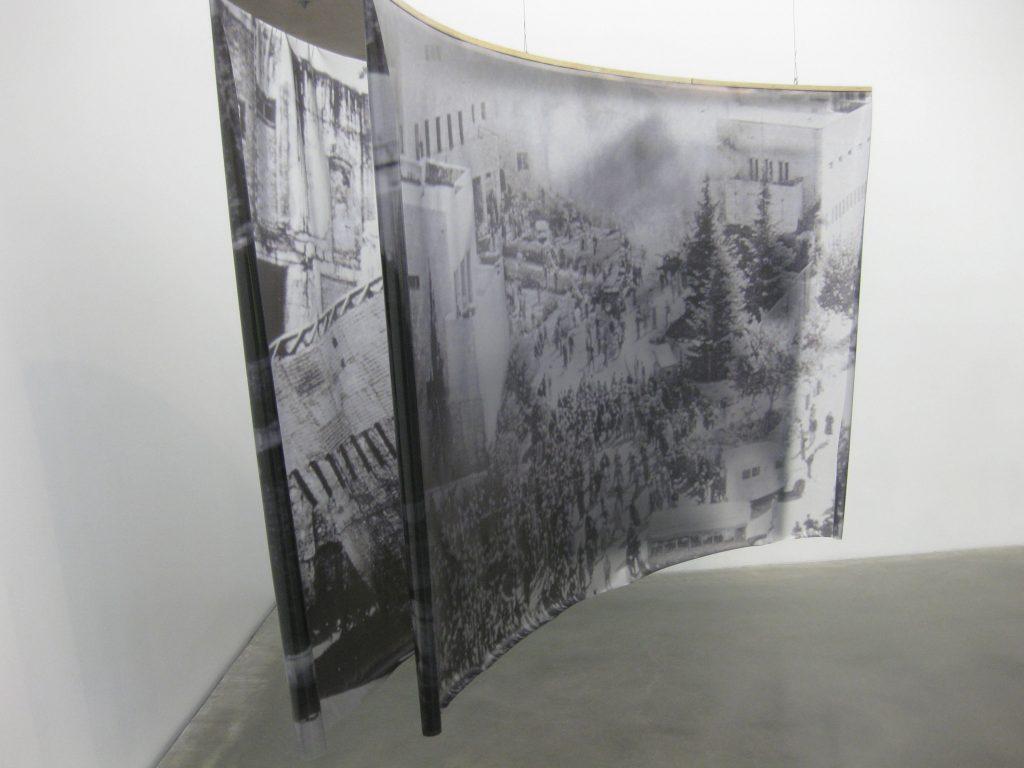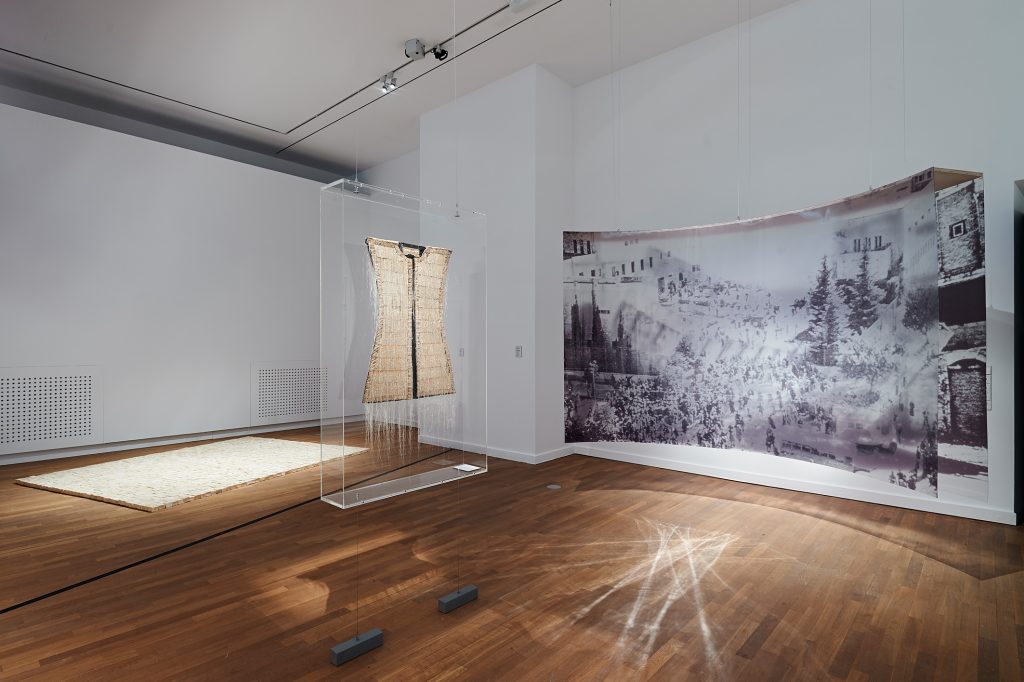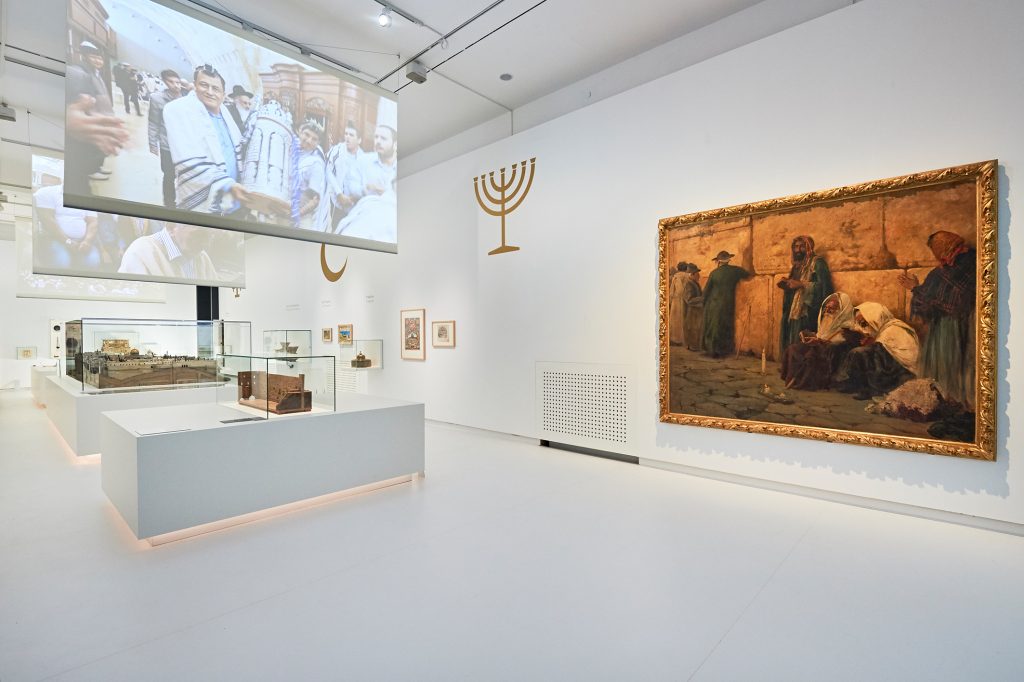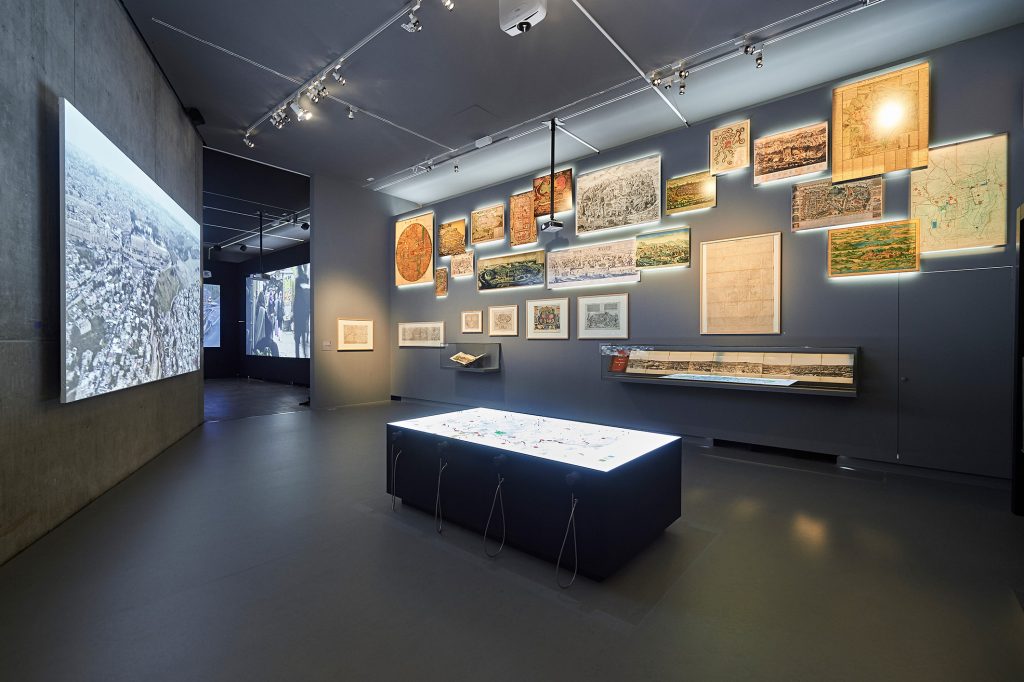The last room of the exhibition Welcome to Jerusalem at the Jewish Museum Berlin features a long bulletin board where museum staff can pin news articles that address the political issues characterizing today’s Holy City. Recent articles cover United States President Donald Trump’s announcement recognizing Jerusalem as the capital of the state of Israel along with the demonstrations that followed. Photographs of people waving signs, thanking Trump for “Making Jerusalem Great Again” and celebrating the opening of the new embassy, contrast with photographs of protests in the West Bank and the Great March of Return in Gaza, culminating on Nakba Day. The bulletin board brings the exhibition’s representation of the past—its place in the history of ideas, its architectural polemics and ruins, its networks of pilgrimage and migration, its exchange of souvenirs between tourists insulated from contested territory— crashing into the present, the material and immaterial layers of Jerusalem’s geography.
Negotiating how space is imagined and enacted in Jewish life is and has been essential to critiquing and remaking Jewishness itself. One need only think of the concluding exclamation of the Passover seder—“Next year in Jerusalem!”—to recognize the continual longing for Jerusalem in Jewish cultural expression. The exhibition about Jerusalem at the Jewish Museum in Berlin is situated as a node in a geopolitical conflict over possession and dispossession that not only includes Berlin and Jerusalem but also involves Jews internationally and migrants seeking asylum within Germany’s borders.
Welcome to Jerusalem’s Berlin location permitted perspectives that could not have been shared within the city of Jerusalem itself, in particular through the inclusion of artworks that address the violence and displacement giving shape to the state of Israel. However, the curation of art to address settler-colonial violence inadvertently highlighted some institutional limits. In the context of geopolitical conflicts over possession and dispossession, institutions premised on the preservation of objects face difficulties in addressing how meanings attached to those objects have changed, especially in the contexts of colonialism and decolonization.
As Jewish longing for Jerusalem has condensed into the ideology of political Zionism and manifested in the expropriation of land from Palestinians, objects symbolizing the city raise questions of interpretation that must be addressed. Itself an object of sorts, the Museum became similarly imbricated in Germany’s debates around migration and displacement, often filled with racist vitriol directed against asylum-seekers and the families of Turkish guest workers. When walking through the exhibition detailing the fluctuation of borders and the movement of people in relation to those borders, it felt as though Germany was instrumentalizing Jewish history in a performance of reconciliation while diverting hostility regarding communities in precarious positions relative to the nation-state. The exhibition is thus located at a geopolitical crossroads that calls into question the intersecting meanings ascribed to its objects and symbols.
The challenges involved in addressing how transhistorical objects and discourses change in relation to contemporary circumstances take on a particular urgency in the context of Jewish sovereignty and the displacement of Palestinians. Artifacts and reconstructions in the galleries provide evidence of pilgrimage to the city and the evolution of its holy sites, all of which predate the establishment of the state of Israel. Many of these objects portray Jerusalem in a symbolic manner, informed by spiritual desire and the experience of exile.
One such object is a machzor—the prayer book used during the Jewish High Holy Days—with an illustration on the last page of a messianic figure riding a donkey into Jerusalem. The machzor was printed in 1709 in Corfu, an island located along Greek’s West coast, where Jews have lived from the 12th century. The image illustrates a prophecy of Zechariah’s during the period following the Babylonian exile, understood by many Christians to have been fulfilled by Jesus Christ. The image in the machzor represents not just a return, but the return: the transformation of the wandering Jew into the Jew who has returned, recovering the sacred Jerusalem, portrayed here as a walled city with no inhabitants. The last page of the machzor would not only close the ritual period during which Jews pray to be inscribed in the Book of Life, but also it would provide the Jews of Corfu an origin point and destination, binding them together and linking them with Jews around the world. The machzor comes from 18th-century Greece, but today it elicits a response informed by dramatically different cultural paradigms, fundamentally altering the objects and practices connected with them.
Longing for a symbolic Jerusalem has been literalized over the course of history, from migration to the physical space of Jerusalem and the subsequent domination of Zionism as a political movement. However, the museum’s ideology of preservation, cordoning the machzor to a gallery representing Jerusalem’s religious past, ultimately partitioned the machzor from Jerusalem’s political present, foreclosing consideration of the historical longing for Jerusalem alongside the state of Israel today. Even as the Museum aimed to create a dynamic, living exhibition—even incorporating the audible voices of Jerusalem’s current residents throughout—any lapse in accounting for the effect of political sovereignty on changing cultural paradigms ultimately reinforces the machzor’s image of an uninhabited Jerusalem.
In contrast to the Museum’s display of the machzor, an artwork included later does help to unpack how cultural forces change around a particular object, site, or expression, especially within a context of settler-colonial violence. A gallery toward the end of the exhibition engages directly with the violence that dominates ideas about Jerusalem today, showing contemporary artworks from the late 1990s onward by Mona Hatoum, Gustav Metzger, Fazal Sheikh, Andi LaVine Arnovitz, and Wolfgang Strassl. Metzger’s work, entitled Historic Photographs: Jerusalem, Jerusalem (1998), demonstrates a capacity to engage the destruction that haunts pilgrimage sites.
Born in Germany in 1926, Metzger lost most of his family to the Shoah and developed an artistic practice around investigating forces of destruction, weighing both man’s power to bring about degradation and the potential for art objects to exceed the control of their creators.
In Jerusalem, Jerusalem, two semi-transparent PVC foils printed with photographs hang from the ceiling in concentric arcs. One foil is printed with an event that took place on March 11, 1948, when a bomb was planted in the courtyard of the Jewish Agency. The other foil is printed with an event from June 10, 1967, when Israeli forces captured the Old City of Jerusalem and used bulldozers to destroy the Mughrabi Quarter, making way for the plaza in front of the Western Wall. Separating the photographs is an inaccessible, empty space and, between the images they represent, a temporal distance of 19 years and three months.
But the layered semi-transparent surfaces muddle them both in one haze of destruction. One’s gaze passes through an image of the Jewish Agency, which continues today to facilitate the migration of Jews to the state of Israel, to one of the Mughrabi Quarter, the absence of which helped propel the Western Wall to a new devotional significance. Metzger sets up the Western Wall as an enclosure, encircling the viewer while centralizing Jewish pilgrimage and compressing the sacred with the national. This emblem of military victory monopolizes the sacredness that once infused Jerusalem’s soil. But the museum’s reliance on artworks to bear the burden of addressing the unavoidable violence of contemporary Jerusalem enabled the Museum to avoid explicitly taking an institutional position in relation to the ongoing violence.
The Jewish Museum’s very building, like the machzor and the Western Wall, demonstrates yet another clash between an object or site and its cultural, political, or geographical locations. Scholar James E. Young compellingly argues that Daniel Libeskind designed the building of the Jewish Museum to give Germany’s violence against Jews the form of a void, resisting the forms of German-Jewish reconciliation; but others, including Hannah Tzuberi, have explored how the the “good Jew” becomes a tool of state legitimation in Germany, in ways that possibly overtake the challenge of the Museum’s form. While Jewish representation within German cultural institutions often corresponds to violence and its aftermath, this representation occupies a privileged position in relation to those deemed by the state as more threatening.
The varied historical and political topography of Jerusalem thus plays out today in confrontations over the meaning of historical objects, sites, and reading practices. Chapter five of Pirkei Avot describes ten miracles performed in the Holy Temple in Jerusalem. Two of these miracles are that “a snake or scorpion did not hurt a person in Jerusalem” and “a person did not say to his fellow, ‘the place is too cramped that I should lodge in Jerusalem.’” By including these two miracles, which took place in greater Jerusalem, among those that took place at the Temple, the rabbis represent Jerusalem both as a repository for the Temple and also as a broader space infused with the holiness of the Temple; Jerusalem becomes a place of radical inclusion and safety for those who wish to dwell there. Jerusalem’s intertwined spiritual and physical qualities immanentize the Shechina, or divine presence, while furnishing worshipers with a particular space for Jewish devotion, operating across the border of the material and immaterial.
Yet Pirkei Avot also includes text that draws on the experience of exile and presents the Shechina as wholly dematerialized and delocalized. In chapter three, it is written, “Two who are sitting together and there are words of Torah [spoken] between them, the Divine Presence rests with them.” The place of the Temple transforms into the place of practice and study. Rabbi Akiva goes on to describe masoret (tradition) as a “safeguarding fence around Torah.” Tradition constitutes an immaterial fence, and study and commentary constitutes the basis of practice. Jerusalem remained a reference point in this spiritual orientation, but largely an immaterial one evoked from afar, thus representing Jerusalem as a site that moves between the material and the immaterial in relation to larger cultural upheavals. So too we might understand the exhibition’s materials—each relating differently to the symbolic and physical Jerusalem—not as stable objects, but rather as loci of practice that we might revisit in light of our changing social relations.



